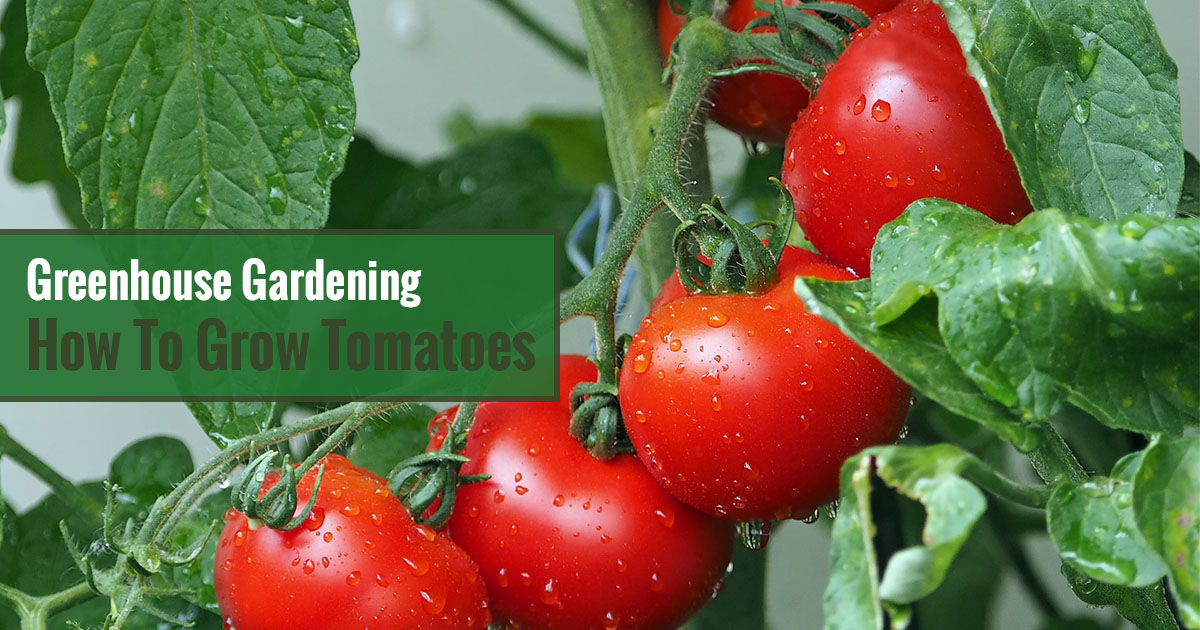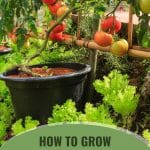
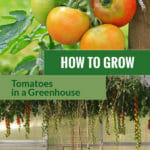
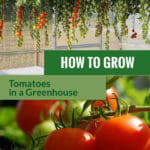

Growing tomatoes is like a rite of passage when it comes to greenhouse gardening. If you’ve ever tasted a tomato fresh from the garden, you know that store-bought ones will never be able to compare.
If you love home-grown tomatoes as much as we do, you’ll probably be wondering how you can grow them in a greenhouse. Tomatoes are a popular greenhouse crop because they love the warm and protected environment that a greenhouse provides.
To ensure a plentiful harvest of delicious tomatoes, you’ll need to understand how to properly care for tomato plants. Maintaining proper greenhouse conditions means providing good lighting, temperature, and pollination, while practicing good pest and disease management.
Growing tomatoes in a greenhouse is an excellent choice, allowing you to extend your growing season regardless of your climate. With some care, you can easily get multiple harvests of tomatoes from your greenhouse plants. Keep reading to learn how you can successfully start growing tomatoes in your greenhouse!
Is a tomato a fruit or a vegetable?
Are tomatoes fruits or are they vegetables? If you’ve ever wondered this, you’re not alone!
Botanically speaking, a fruit is the “ripened ovary of a flowering plant.” This definition would include such foods as tomatoes, apricots, beans, and even almonds. Popularly, however, the word “fruit” usually refers to foods that are sweet and fleshy while “vegetable” indicates lower fructose. From a culinary perspective, vegetables are usually used in savory dishes.
To make matters more confusing, did you know that the US Supreme Court decided in 1893 that tomatoes are vegetables notwithstanding the botanical definition of a fruit? So, technically a tomato is the fruit of a tomato plant, but it’s legally regarded as a vegetable and used as such in the kitchen.
Ultimately, it doesn’t matter whether you call a tomato a fruit or a vegetable, you can grow it either way!
Choosing the type of greenhouse tomato plant
As with other popular crops, there are many different varieties of tomatoes. Each variety has unique features such as taste, appearance, and storing quality. Because there are so many different kinds out there, it can be daunting to choose which one to grow in your greenhouse, but that’s what we’re here for.
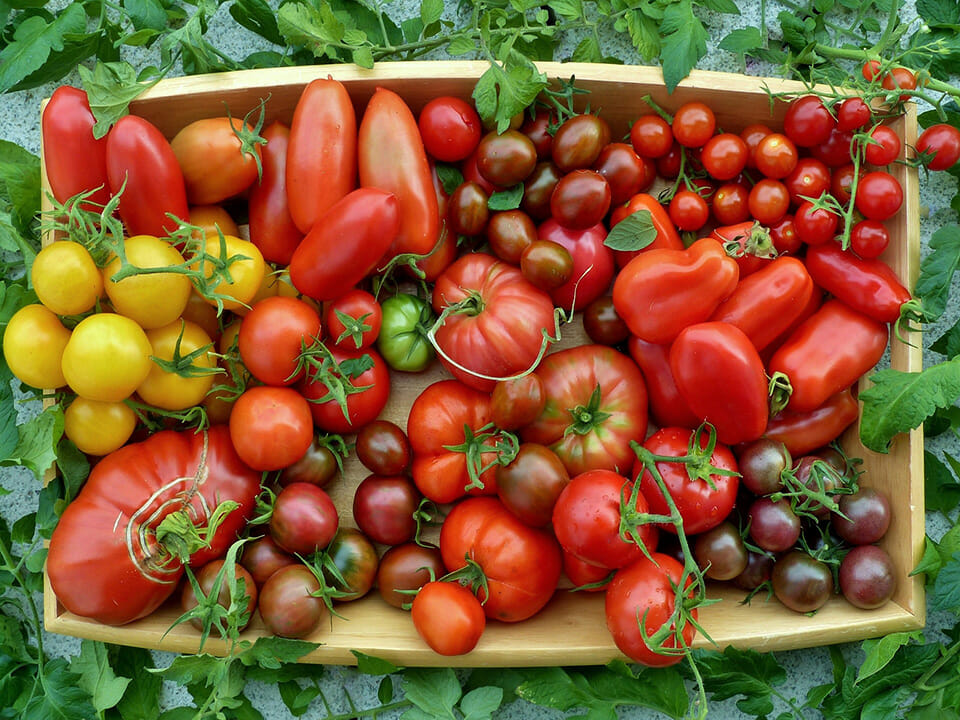
Before we get into our favorite varieties of greenhouse tomatoes, you should know that there are three different types of tomato plants: indeterminate, determinate, and semi-determinate.
Cordon or indeterminate tomatoes
Indeterminate tomato plants will grow extensively unless pruned or killed by frost. Fruit is set on shoots coming from central vines or stalks, which appear continuously as the plant grows. This results in an extended harvest of tomatoes, with the plant showing different stages of fruit growth at all times.
You can grow indeterminate tomato plants in raised beds, grow bags, or directly in the garden when soil temperature reaches above 55°F. Because of their growth habit, you’ll need to support them with stakes or tomato cages. Indeterminate tomatoes are the most popular and are usually pruned as single-stemmed plants by eliminating suckers or side shoots.
Bush or determinate tomatoes
Unlike indeterminate varieties, determinate tomato plants develop reasonably compact bushes with shorter stalks. As a result these are perfect for growing in a smaller greenhouse. Determinate tomato plants will stop growing vertically after a while, at which point they’ll continue developing on side shoots. Their fruit tends to ripen all at once, which makes them great for processing.
Determinate tomatoes are best grown in large pots, raised beds, or grow bags. Use containers that can hold at least five gallons of soil with proper drainage. Mix in new, quality potting soil with organic matter. Determinate varieties don’t require as much support, but it can still be beneficial to add staking. Container plants will need regular watering. Never prune side shoots, because these are your tomato’s fruiting shoots.
Some determinate tomatoes are labeled as “dwarf varieties” which will be even smaller and are suitable for growing in pots. These usually don’t require any pruning.
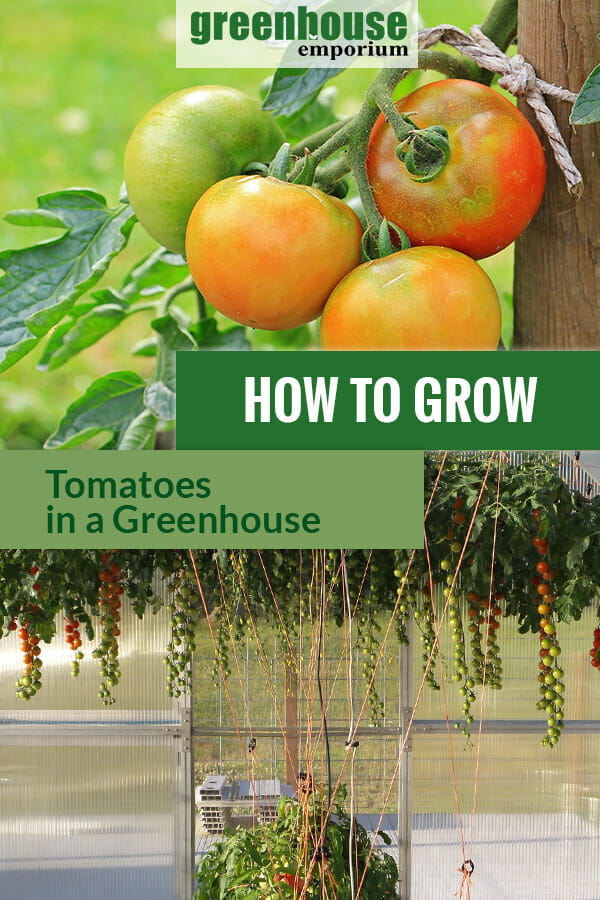
Semi-determinate tomatoes
As the name suggests, semi-determinate varieties have some of the qualities of both determinate and indeterminate tomato plants. These varieties tend to grow indeterminately with shorter vines, making them more compact. However, there are some semi-determinate tomatoes that will fruit like determinate plants, so it really depends on the particular variety.
Semi-determinate tomatoes can be grown in pots or raised beds, and usually require minimal pruning to maintain. Some staking is usually beneficial to keep fruit off the ground.
Best tomato varieties for a greenhouse
Now that you understand the habits of the three main kinds of tomato plants, it should be easier to choose specific tomato varieties based on your greenhouse. Although it may be difficult to select just a few tomato varieties to grow, we recommend starting with just 2-3 varieties to make managing them easier.
When selecting a variety, choose seeds that are marked as ‘greenhouse varieties’ since these are tolerant of the conditions inside a greenhouse. Additionally, tomato seeds labeled with VFNT are resistant to common tomato diseases (verticillium wilt, fusarium wilt, nematodes, and tobacco mosaic virus). Some sellers make you pick specific diseases, though.
While you might already have an idea of which tomatoes you’d like to grow (and eat), here are some of our top picks for greenhouse growing:
Cherry tomatoes
Cherry tomatoes are small and sweet, making them a great addition to any greenhouse. They can start producing fruit in less than two months from transplanting, and you’ll find it hard to resist eating them all on the spot.
Any cherry tomatoes that do make it as far as the kitchen are ideal for salads and pasta recipes. Some of our favorite varieties include Sungold and Black Cherry. Usually indeterminate.
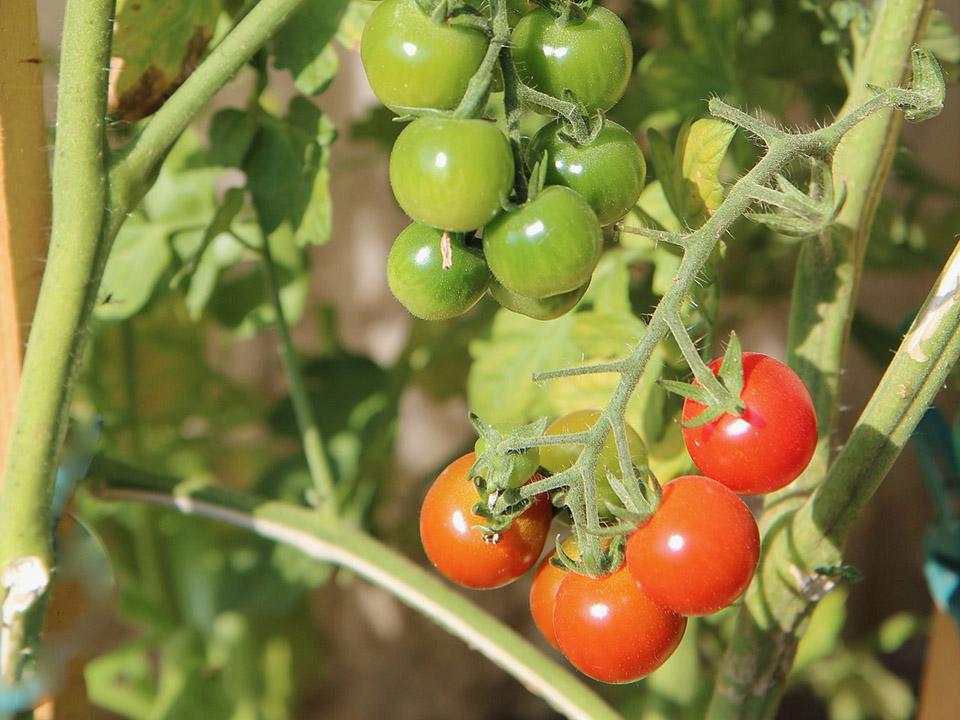
Plum tomatoes
Plum tomatoes are fleshy, usually have fewer seeds, and are excellent for fresh use in salads or for later use by processing into a sauce or paste. Plum tomatoes are larger than cherry tomatoes and have an oblong shape.
Plum tomatoes include such popular varieties as San Marzanos, Regal Plum, and Amish Paste. Varieties can be either determinate or indeterminate.
Beefsteak tomatoes
Beefsteak tomatoes are amongst the largest and heaviest tomatoes. These tomatoes have a lean texture which makes them perfect for grilling, packing, or slicing for use on sandwiches.
The flavor of a beefsteak really comes through when allowed to ripen on the vine, but one of the advantages is that these can be picked earlier for longer storage or even transportation. Popular varieties that do well in greenhouses include Pink Wonder and Purple Cherokee. Usually indeterminate.
Best greenhouse tomato seeds from our partners
We know it can be hard to pick the right tomato seeds to grow in your greenhouse. There are so many options out there. To help you along your journey, we did the research and tested a few greenhouse tomato seeds.
Used abbreviations: verticillium wilt (V), fusarium wilt (F), fusarium crown & root rot (FCRR), nematodes (N), leaf mold (L), tobacco mosaic virus (T), tomato mosaic virus (ToMV), tomato apex necrotic virus (ToANV), grey leaf spot (GL), bacterial speck (B), tomato spotted wilt virus (TSWV)
High Mowings Organic Seeds:
- Enroza Tomatoes: Dense, juicy, and remarkably uniform fruits, highly productive plants to set fruit continuously; Hyloom; Indeterminate; Resistances: V, F, L, FCRR, ToMV, ToANV, GL
- Sakura Cherry Tomatoes: Produces juicy, flavorful fruits on trusses (10-12 fruits); Hybrid; Indeterminate; Resistances: F, L, T, N
- Bartelly Cherry Tomatoes: Sweet, well-balanced fruits, perfect for unheated greenhouses and high tunnels; Hybrid; Indeterminate; Resistances: L, T
- Arbason Tomatoes: Produces large, high-quality tomatoes; Hybrid; Indeterminate; Resistances: F, V, T
Botanical Interest – Organic and Heirloom Seeds
- Supremo Bush Tomatoes: Impressively large, uniform roma tomatoes with heat resistance; Determinate; Hybrid; Resistances: F, V, N, B, TSWV
- Ace 55 Bush Tomato Seeds: Heirloom seeds from the 1950s producing delicious, lower-acid tomato fruits; Determinate; Resistances: V, F
- Artisan Bumble Bee Blend Pole Cherry Tomato: Pink, purple, and sunrise-colored cherry tomatoes; sweet, tangy and juicy fruits with unique stripes; Indeterminate
- Yellow Bush Cherry Tomatoes: Beautiful yellow cherries on a space-saving plant, deals well with heat and humidity but is frost-sensitive; Hybrid; Determinate; Resistances: F, V, T
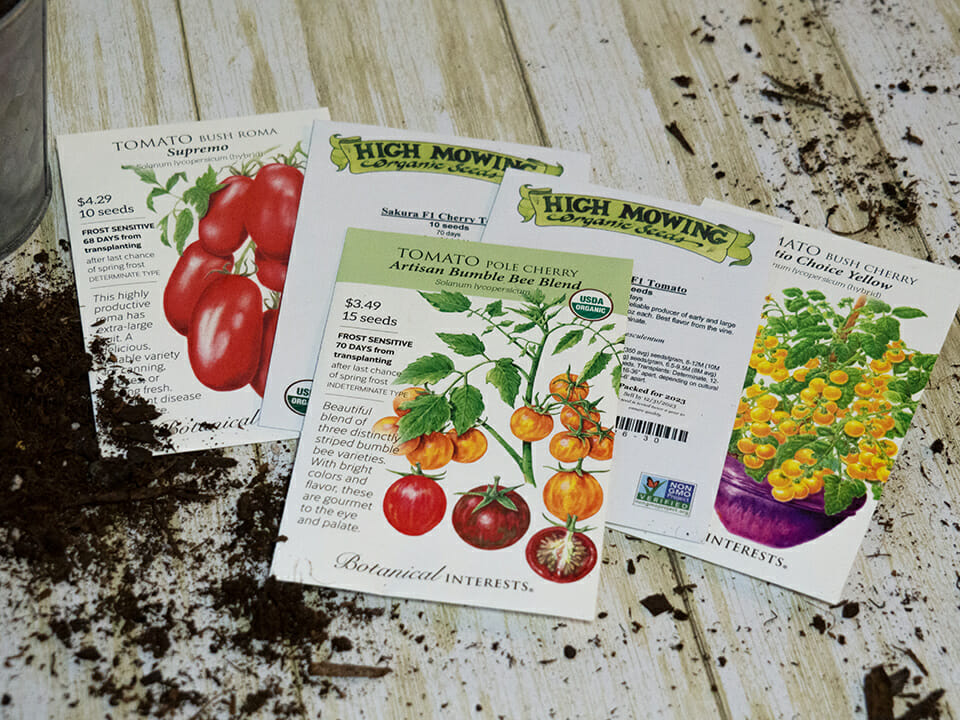
How to set up your greenhouse for your tomatoes
Once you’ve selected which tomatoes you’d like to grow and bought the seeds, it’s time to plant them and get your greenhouse ready!
The first step to setting up your greenhouse involves monitoring the temperature. Tomato plants provide better yields when daytime temperatures range from 70-80°F and nighttime temperatures from 60-65°F. You can raise the temperature inside of your greenhouse by improving insulation and installing a heater until the weather warms.
Here are other things to keep in mind as you’re getting ready to plant your greenhouse tomatoes:
- Generally, tomatoes thrive in well-draining soil mixed with perlite, vermiculite, or sphagnum peat moss. Because they’re heavy feeders, it’s a good idea to mix in organic matter such as compost before planting.
- We recommend using a drip irrigation system in your greenhouse when growing tomatoes. Not only does drip irrigation provide a steady supply of water directly to the root system, but you can also use it to automate fertilizer application. Most importantly, drip irrigation prevents the leaves and fruit of your tomato plants from getting wet, which can invite disease or result in fruit splitting.
- Keep the humidity below 90% to prevent leaf mold. Proper ventilation is key to lowering humidity particularly when it’s cold or wet.
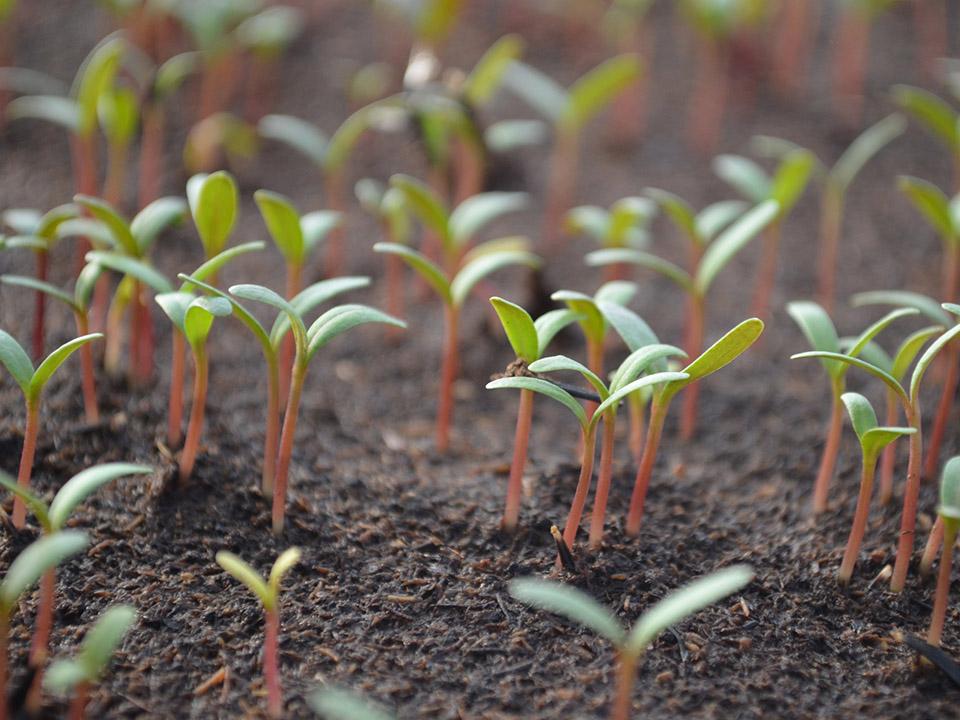
How to grow tomatoes in a greenhouse
With your greenhouse all set up and ready to welcome the bushy growth of tomato plants, it’s time to get to planting them! We’ve laid out the most important steps below:
- To plant tomato seeds, you can either use a standard seeding tray or a soilless tray and seed nutrient solution. RSI Hydroponic Floating Seeding Trays will give you a high success rate when it comes time to transplanting your tomatoes.
- Prepare your seeding tray by adding a seedling soil mix and moistening with water. Use plain, filtered water until the mixture is just wet enough that when squeezed only a few drops come out.
- Poke a small, shallow hole inside every cell and add a single seed. Cover carefully with your potting mix. Make sure that you plant about 10-15% more seeds than the number of plants you intend on growing so that you can select the strongest seedlings.
- Tomato seeds normally sprout in 1-2 weeks under the right conditions. If your greenhouse ambient temperature is below 65°F, consider placing a heating mat below the tray to speed up germination.
- Once seedlings emerge, ensure that the trays are exposed to ample light. Grow lights will provide your seedlings all the light they require to thrive even in winter.
- When your seedlings have 1-2 sets of true leaves, transplant them into individual pots. They’ll be ready for transplanting into the ground or raised beds when they are at least 6” tall.
- Remember that indeterminate varieties may bear less fruit if grown in a container, so choose an appropriate size for each plant. Alternatively, you can plant your tomatoes along the greenhouse border to give them more space to grow and better access to sunlight.
- Tomato plants are heavy feeders, so apply a nitrogen- and potassium-rich fertilizer every few weeks throughout the growing season.
- Indeterminate tomato plants require regular pruning. Remove suckers and gently guide the plant along its stake, trellis, or cage for support.
- Once the plants begin to flower, you may need to encourage pollination by shaking (to mimic wind), opening doors/windows to invite natural pollinators, or use a mechanical pollinator to ensure proper fruit setting.
Caring for your greenhouse tomato plants
Tomatoes might be one of the most popular plants to grow in a greenhouse, but they do require some care in order to ensure a plentiful harvest. Luckily, most problems can be easily prevented and managed.
How to properly water your greenhouse tomato plants
When it comes to growing tomatoes in a greenhouse, the best thing you can do to keep your plants healthy and prevent disease is to maintain a regular watering schedule. Not only does proper watering ensure a bountiful crop, but it reduces the risk of drought stress or overwatering.
Avoid watering tomato plants from above, instead consider installing a drip irrigation system or simply watering at ground-level. Make sure to check the soil regularly for moisture. If the top 2” of soil feels moist, wait to water for another day or two. On the other hand, if it’s dry, it’s time to water.
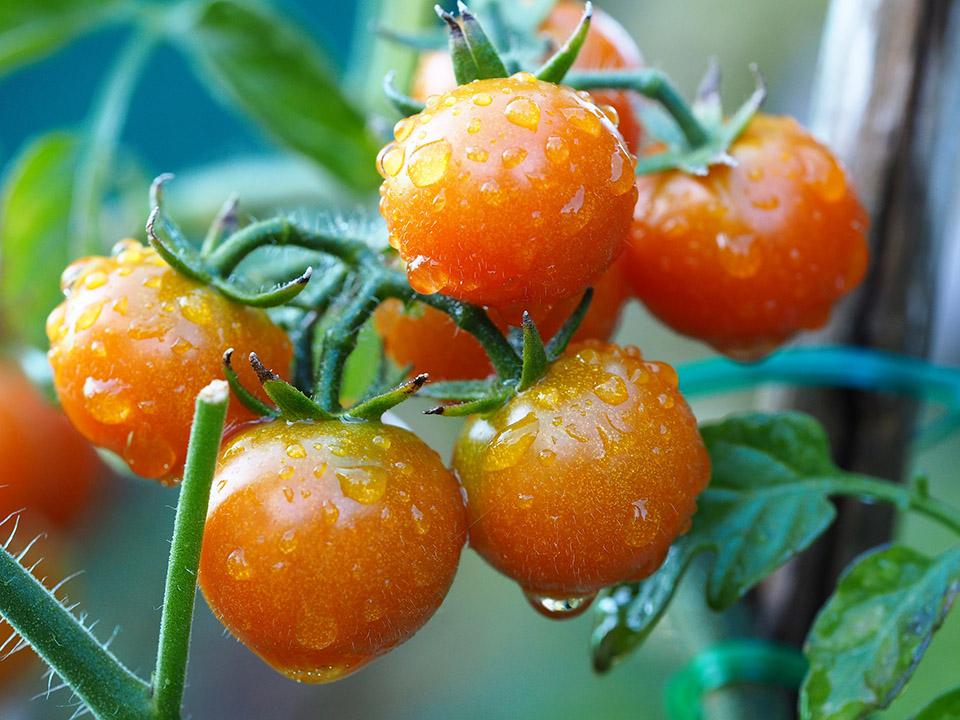
Why are my tomato plants not producing fruit?
One of the most frustrating things that can happen with tomato plants in a greenhouse is when the plants blossom, but the flower buds fall off without forming fruit. Why does this happen and what can you do to prevent it?
The most common reason is improper pollination. Although tomato plants are self-pollinating, they benefit from assistance from wind and pollinators, whether real or simulated. You can simulate wind by shaking the plant, causing the flowers to distribute pollen. You can also use a mechanical pollinator, or simply invite natural pollinators inside by opening up the door of your greenhouse during the day.
Less common, extreme temperatures or humidity fluctuations can delay or even prevent proper fruit production.
Pest and disease control for greenhouse-grown tomatoes
When it comes to growing tomatoes, there are a few common pests and diseases to watch out for and take steps to prevent.
Begin by following these steps to prevent any major infestation or infection:
- Properly ventilate your greenhouse to deter pests and diseases.
- Replace old soil or practice crop rotation before growing another batch of tomatoes to prevent pests and root diseases.
- Maintain soil moisture, but be mindful not to over-water since damp soil may promote the spread of disease and mold.
- Don’t install an overhead irrigation system because the leaves of tomato plants are susceptible to disease when wet.
- Prune dead or dying leaves to allow more sunlight and airflow.
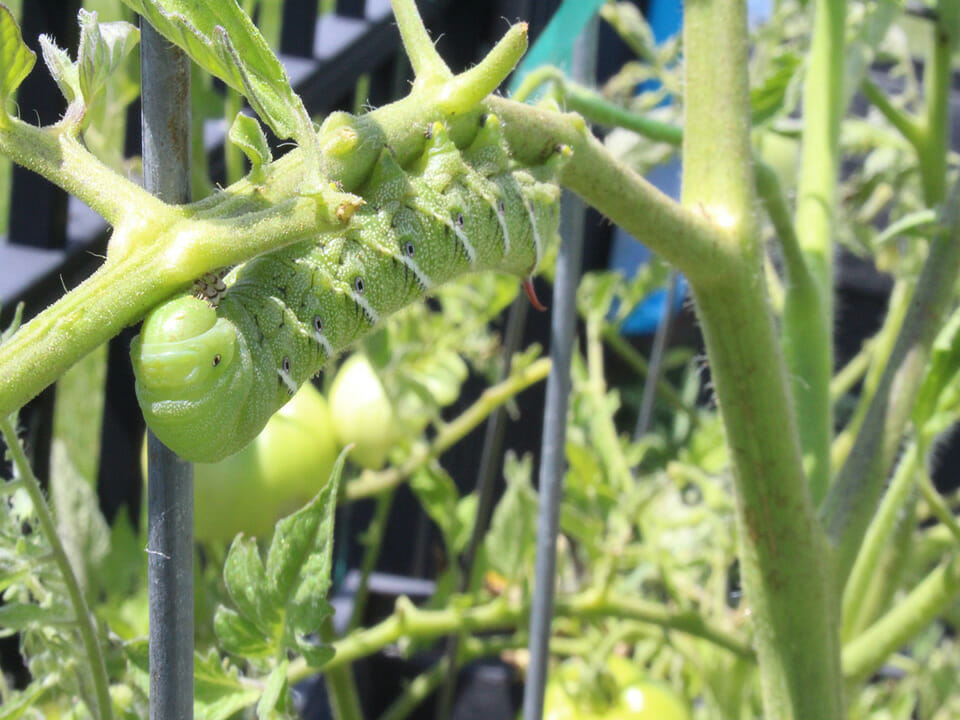
Common tomato pests and diseases to watch out for
While not a complete list, there are a number of pests and diseases that can attack your tomato plants in the greenhouse. Here are some of the most common ones, and how to spot them:
- Aphids: these tiny, soft-bodied insects can be found clustered anywhere along the stems or leaves of your tomato plants. Prune damaged leaves and manually remove aphids by shaking the plant vigorously or spraying with organic insecticidal soap.
- Tomato hornworm: tomato hornworms are the large, bright green caterpillars of the five-spotted hawk moth. These vigorous eaters can destroy the leaves and fruit of your tomato plant if left unchecked, so inspect your plants regularly and drop any you find in a bucket of soapy water.
- Damping off: this disease is caused by a variety of plant viruses and particularly affects young, fragile seedlings. Infected plants will suddenly wilt and rot at the soil line. To prevent damping off, make sure to use new potting soil, clean trays and tools, and avoid overwatering seedlings.
- Blossom end rot: another unfortunate disease that appears as dark, wet spots on the bottom of the fruit, making it inedible. Rather than a result of a particular virus, blossom end rot is usually a result of insufficient calcium in the soil, drought stress, extreme temperature variability, or root damage. To prevent blossom end rot, make sure to irrigate regularly and maintain steady daytime/nighttime temperatures in your greenhouse.
- Fusarium wilt: this disease is caused by a soil-borne fungus targeting tomatoes, potatoes, peppers, and eggplants. Early indications include yellowing leaves or brown, smeared tissue on the stalk. Cool and soggy conditions can allow this disease to establish, so make sure to maintain proper greenhouse temperatures and resist overwatering.
- Septoria leaf spot: another common disease that can affect your tomato plants is Septoria leaf spot, caused by the fungus Septoria lycopersici. This disease appears as brown spots on foliage, moving upwards from older leaves to newer leaves. If you can spot this early on, you should be able to prevent the spread by pruning diseased leaves.
Harvesting your greenhouse-grown tomatoes
After months of carefully managing your tomato plants, the first fruits are finally starting to mature!
You can harvest tomatoes at any time depending on how ripe you want them to be. The longer your tomatoes stay on the vine, the fuller and redder they will be. Simply pull the tomato off the vine or cut them off using a pair of garden pruners. Don’t place harvested tomatoes in a sunny spot to continue ripening because this can cause them to rot before you’ve even had a chance to eat them.
How to properly store and process tomatoes
There are many ways to store harvested tomatoes. Of course, they’re best eaten straight off the vine, but chances are you have more tomatoes than you know what to do with. They’ll continue ripening once picked, so don’t leave them out on the counter for more than a week.
If you have too many tomatoes at once, you can preserve them by canning or freeze drying. You can also make delicious pasta sauces for preserving or freezing, make homemade tomato paste or ketchup, or simply freeze them for later use.

